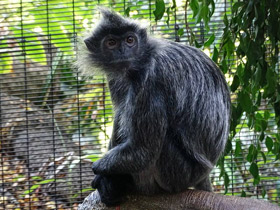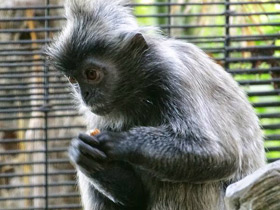The silvery lutung(Trachypithecus cristatus), the silvered leaf monkey or the silvery langur
The silvery lutung (Trachypithecus cristatus), also known as the silvered leaf monkey or the silvery langur, is an Old World monkey. It is arboreal, living in coastal, mangrove, and riverine forests in Peninsular Malaysia, Sumatra, Borneo, Java, and other nearby islands.
It is the type of its species group.
Habitat area
Trachypithecus cristatus is a species of catarrhine primate in the family Cercopithecidae. Trachypithecus cristatus is common in the coastal forests and mangrove swamps of Malaysia and the islands of Sumatra and Kalimantan in Indonesia, as well as on some small islands nearby. These primates prefer to stay close to rivers.
The number and identity of subspecies of the silvery lutung is currently debated. A 2008 analysis confirms the presence of only two subspecies:
- Trachypithecus cristatus cristatus - Borneo, Sumatra, Natuna Islands;
- Trachypithecus cristatus selangorensis - Malay Peninsula.
The Malay Peninsula form has been subsequently elevated to a separate species, the Selangor silvered langur Trachypithecus selangorensis
However, some older sources, such as Mammal Species of the World, as well as some much newer ones such as the 2021 edition of the IUCN Red List, distinguish the silvery lutungs of the Natuna Islands as a separate subspecies, designated Trachypithecus cristatus vigilans.
Appearance and peculiarities
They are medium-sized primates with a long tail. The coat is black or dark brown. The hairs are grey at the tips, which gives the coat a silvery sheen. Unlike closely related species, these monkeys have no light-coloured markings on the face and body, except for a light spot on the female's crotch. It has a crest on the head and pronounced sideburns. The feet and palms of the hands are hairless, the skin is black and the thumbs and toes protrude. The body length of females is 46 to 51 cm, weight about 5.7 kg, tail length 67 to 75 cm. Males are slightly larger, measuring 50 to 58 cm in length and weighing about 6.6 kg, with a tail length of 67 to 75 cm.
Like other langurs, Trachypithecus cristatus has a three-chambered stomach, allowing it to process cellulose, which is rich in its diet. They specialise in eating leaves. The proportion of leaves in the diet is higher than in other monkeys. Fruits, seeds and flowers are sometimes included in their diet, but these comprise only 9% of their diet. They prefer to feed in the middle levels of the forest.
Trachypithecus cristatus is highly susceptible to human diseases, including AIDS, and is therefore often used in medical research.
Social behaviour
Trachypithecus cristatus are diurnal animals that form groups of 9 to 40 individuals consisting of a mature male, several females and their young. They rarely descend to the ground. Each group covers an area of 20 to 43 hectares. At night, the whole group gathers in a tree. Females remain in the group all their lives, females leave the group when they reach puberty, sometimes grouping with their own kind until they have their own harem.
As group territories overlap, contact between groups is common. Each group tries to scare its neighbours with sounds, sometimes males from different groups fight.
Reproduction
Trachypithecus cristatus breeds throughout the year, with no definite mating season, although females do not usually produce young more often than every 18-24 months. The female attracts the attention of the male by moving her head from side to side, mating may occur several times during the encounter.
Pregnancy lasts 181 to 200 days, the litter usually contains a young of about 400 g and about 20 cm in length. From birth, the calf clings to its mother. The coat colour of the pups is orange; as they grow, it becomes darker. The cubs are cared for not only by the mother, but also by the other females in the group. Until they are 18 months old, the young are fed on milk. Females reach sexual maturity at two years of age and have their first calf at three years of age on average. Longevity in captivity is up to 31 years.
Diet
The silvery lutung is a specialist folivore, including a higher proportion of leaves in its diet than any other colobine monkey. Although it does also eat fruit, and some seeds and flowers, these comprise only 9% of the diet, and it is also able to feed on tougher and more mature leaves than any of its close relatives. Because of these differences, silvery lutungs do not normally live in the same parts of the forest as other monkeys. Where other species are found in the same area, silvery lutungs are more commonly found in the middle canopy of the forest, leaving the higher branches to monkeys with a more frugivorous diet.
Predators
Local predators able to feed on silvery lutungs include leopards, tigers, dholes, and some large snakes. Binturongs, and various other small carnivores are probably able to feed on infants.
Diseases
Silvery lutungs are unusually susceptible to human diseases, including AIDS, and have therefore been widely used in medical research.
Evolution
Genetic analysis has shown that the silvery lutung probably first evolved during a rapid speciation event that occurred between 0.95 and 1.25 million years ago, during which all the living species of the Trachypithecus cristatus species group evolved. Because of the relative speed and diversity of this event, the species of the group are difficult to distinguish genetically, and there is some uncertainty as to which represent genuinely distinct species. However, the closest living relative of the silvery lutung may be the Javan lutung, although silvery lutungs have also been reported to produce hybrids with Phayre's leaf monkey, generally considered to belong to a different species group.
Fossils of the species are known from the late Pleistocene onwards, and occupy the same geographic range as today. Some of these fossils had significantly larger cheek teeth than living animals, although they have not been assigned to a distinct subspecies.
Conservation
The silvery lutung is classed as vulnerable by the IUCN, and is listed in Appendix II of CITES. Its habitat is heavily threatened throughout its range by logging and the development of oil plantations. The species is also threatened by hunting for meat and by capture for the pet trade.



















































